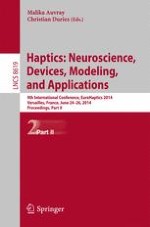2014 | OriginalPaper | Chapter
Modeling the Weber Fraction of Vibrotactile Amplitudes Using Gain Control Through Global Feedforward Inhibition
Authors : Ken E. Friedl, Yao Qin, Daniel Ostler, Angelika Peer
Published in: Haptics: Neuroscience, Devices, Modeling, and Applications
Publisher: Springer Berlin Heidelberg
Activate our intelligent search to find suitable subject content or patents.
Select sections of text to find matching patents with Artificial Intelligence. powered by
Select sections of text to find additional relevant content using AI-assisted search. powered by
